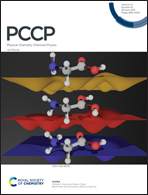Where do the counterions go? Tip-induced dissociation of self-assembled triazatriangulenium-based molecules on Au(111)†
Abstract
Chemical coupling of functional molecules on top of the so-called platform molecules allows the formation of functional self-assembled monolayers (SAMs). An often-used example of such a platform is triazatriangulenium (TATA), which features an extended aromatic core providing good electronic contact to the underlying metal surface. Here, we present a study of the SAM formation of a TATA platform on Au(111) employing scanning tunneling microscopy (STM) under ambient atmospheric conditions. In solution, the TATA platform is stabilized by BF4 counterions, while after deposition on a gold substrate, the localization of the BF4 counterions remains unknown. We used 1,2,4-trichlorobenzene as a solvent of TATA–BF4 to induce SAM formation on a heated (∼50 °C) Au substrate. We show by STM how to detect and distinguish TATA–BF4 from TATA platforms, which lost their BF4 counterions. Finally, we observe a change of the counterion position on the SAM during the STM scanning, which we explain by an electric-field-induced decrease of the electrostatic interaction in TATA–BF4 on the surface. We applied DFT calculations to reveal the influence of the gold lattice and the electric field of the STM tip on the stability of TATA–BF4 physisorbed on the surface.



 Please wait while we load your content...
Please wait while we load your content...